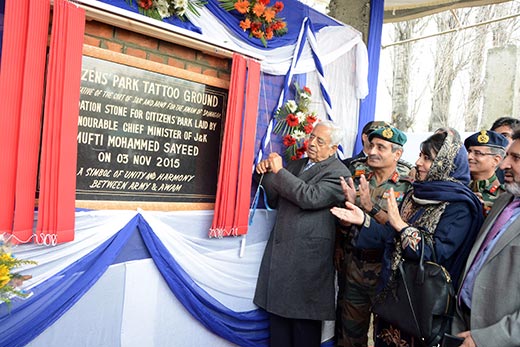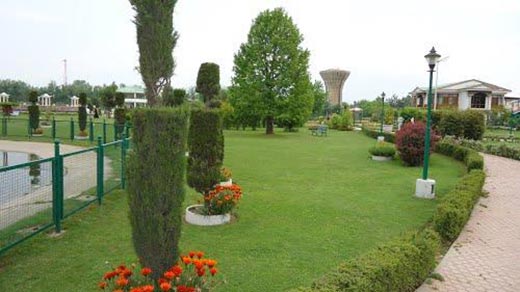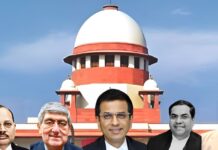With a small portion of the Tattoo Ground retrieved from army for a public park, the government’s struggle spanning decades has barely started bearing fruit. But is there a possibility of the vast swathes of land around Batamaloo ever being demilitarized to help city breathe, asks Mohammad Raafi
 Government announcement that part of the sprawling Tattoo Grounds would be a public parkpushed Ghulam Muhammad Bangroo, an 80 year old Chattabal resident down his memory lane. He remembers his childhood days when he would be part of the huge cheering ground playing football in the same premises.
Government announcement that part of the sprawling Tattoo Grounds would be a public parkpushed Ghulam Muhammad Bangroo, an 80 year old Chattabal resident down his memory lane. He remembers his childhood days when he would be part of the huge cheering ground playing football in the same premises.
Then, Bangroo says, transport was scarce to the extent that even visiting Mughal Gardens would be difficult. “So people from around the surrounding localities including the down town would converge to spend evenings in this ground,” Bangroo said. “Eids would be different as people from far off places would assemble, spend long hours gossiping, playing football.”
The ground then, had many names. It was Tattoo Ground because Dogra army’s donkeys and mules would remain in this ground even for grazing. Besides, it was known as Chandmari, as soldiers would use it as a firing range. Then, Batamaloo was Srinagar’s peripheral village.
Bangroo remembers being part of various football matches in the ground. However, he specially mentions Dussehracelebrations that this ground would host. Almost a week ahead of the celebrations, Bangroo says effigies of Ravana,Kumbakarna and caricature of Lanka were prepared with Bamboo sticks and stuffed with crackers. “At 4 PM, the jawans of the state forces would line up to receive Maharaja Hari Singh who would come on a horse, would take the salute and then sit in a specially decorated Shamianawith his cabinet and officials,” Bangroo said. “In the evening Maharaja would host the prominent gentry, his ministers and officials and present a souvenir coin to each of them.”
This ground and many other open spaces were quickly occupied by the Indian army soon after it took control in October 1947. As the city expanded, the government felt the requirement of creating more space for the civilian population.
The first effort was made in 1982 when the army vacated around 21 acres (168 kanals) of the Grounds to pave way for setting up of General Bus Stand Batamaloo. The process was set by Ghulam Mohammad Sadiq and later followed by Mir Qasim and Sheikh Abdullah.
In 1988, well before the onset of militancy, the Army had positively responded to the state government request of evicting the place. Then, it was agreed that army would vacate if it gets adequate land in return. This led the state government identify two major karewas’ located in Shariefabad, near Zainakote and Hanjik,Damodar (near the airport). After the army took the possession of the ‘alternatives’, a new situation emerged.
State government and the Defence Ministry agreed in February 1990 on exchange: for 139 acres (1112 kanals) of Tattoo Ground, they got 212 acres (1696 kanals)at Sharifabad and Hanjik. Even President of India gave his accent. Then the preconditions came from Delhi: get us possession first and then state government will have to pay for the assets army leaves in the Grounds!
By then, the ‘war’ had overtaken both the parties. For the army, it would become easier to manage Batamaloo from Tattoo Grounds which, apart from the housing installations of the army would house ‘transit’ detention and interrogation centre. Utility of Damoderkarewa is already part of the folklore. By 1992, the status of the ‘exchange’ was that of the 1622 kanals that army was in possession of at Shariefabad and Hanjikkarewas, 1073 kanals had actually been transferred to the Defence Ministry formally and the balance 548 kanals was in unauthorized occupation of the Rashtriya Rifles. Angry sections within state bureaucracy had suggested claiming Rs 65 crorerent for the occupation of new land stretches.
The issue was taken up again by DrFarooq Abdullah government after the Kargil war. Fearing the issue might become part of the raging human rights and dispossession debate, which was taking shape then, it was talked about calmly.
Initially, army started saying it never got an alterative to Tattoo Grounds. When the babus’ in civil secretariat started dusting the heaps in their vaults, army changed its stand pinpointing that the ‘alternative’ land was 212 acres less that the area it holds in Tattoo Grounds. It was only proved conclusively in December 2009 by Divisional Commissioner Kashmir that army, in fact, had taken possession of more land in exchange of Tatoo Grounds.
Claims and counterclaims led to revelations about the militarized sizes. Army posses a total of 118 acres (944 kanals) of which 93.20 acres (745.6 kanals) are on left side of Srinagar-Baramulla highway from the Bus Stand to Beminacrossing and remaining 24.14 acres (193.12 kanals) are on left side of the same highway from the rear of Chattabal up to Qamarwarioutskirts. This is the diary form of army.
With the army holding the old garrison and converting the new landed estate into a huge battle infrastructure, the state failed to make a change. Then the “wise men” in the civil secretariat came with a new idea. A high level committee constituted in February 2014 recommended that part of land that army illegally occupies in Gulmarg should be bartered with Tattoo Grounds!
The recommendation was rooted in an earlier exercise by the state tourism ministry suggesting that army was in possession of 305.64 acres in Gulmarg and Botapathri. Of this possession of 130 acres was perfectly legal and balance 175.64 acres blatantly illegal. They had suggested formalizing the illegal occupation to retrieve Tattoo Grounds.
It was in this backdrop that Chief Minister Mufti Sayeed drove to Tattoo Grounds announcing that army has evicted from 17 acres which are being converted into a public park.The government got positive commentary for doing the ‘eviction’, albeit small, quietly without any noise, as was associated with demolition of sand-bagged bunkers earlier.
Secretary Tourism Farooq Ahmad Shah in fact detailed the blueprint of what will be all about in coming days.“It will have a multi-cuisine restaurant, state of the art amusement park, swimming pool, coffee shops, library and hi-tech parking facilities,” Shah said.
 Interestingly, Lt Gen SatishDua, the commander of the Srinagar based 15 corpsinsisted that Army and state government have joined together to set up a park. But, he said, Army is working out on the modalities of alternative land against the piece of land that was speared for the park!
Interestingly, Lt Gen SatishDua, the commander of the Srinagar based 15 corpsinsisted that Army and state government have joined together to set up a park. But, he said, Army is working out on the modalities of alternative land against the piece of land that was speared for the park!
It remains to be seen what the state government will eventually do. Will the army get its illegal occupation in Gulmarg formalized or is it eyeing any other spot?
Unable to make anything out of the debate surrounding the Grounds, Taja Begum, a nonagenarian from Downtown, only remembers the days when death would visit even on life-giving days. She has been witness to those events when thousands would throng the Khar Maedan to celebrate the birthdays of Dogra autocrats, which used to be official functions.
“Every year they (Dogras) would celebrate birthday of Gulab Singh, Ranjit Singh and Partap Singh,” Begum remembers. “Lot of people would come as they (Dogras) would distribute rice and clothes on these days to the people. They would call it Ankoot.” The Begum who has witnessed these “celebrations” remembers the casualties taking place. “There would be huge rush for the rice and the clothes and many people would die in the process.”
The Begum does not know that the Grounds might have changed its use but death and life continues to surround it, even today.















